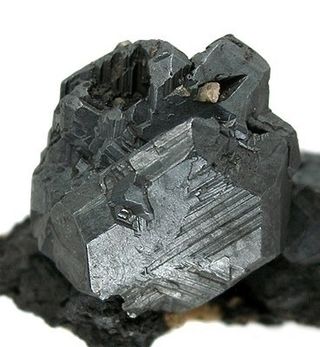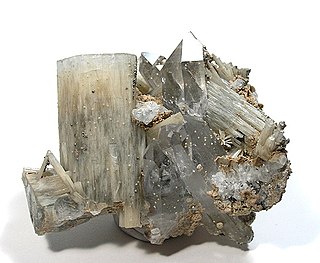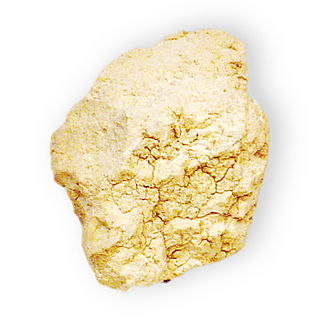| Argutite | |
|---|---|
| General | |
| Category | Oxide mineral |
| Formula (repeating unit) | GeO2 |
| IMA symbol | Agt [1] |
| Strunz classification | 4.DB.05 |
| Dana classification | 04.04.01.07 |
| Crystal system | Tetragonal Ditetragonal dipyramidal class |
| Space group | Tetragonal H–M Symbol: (4/m 2/m 2/m) Space group: P42/mnm |
| Unit cell | a = 4.3975, c = 2.8625 [Å]; Z = 2 |
| Identification | |
| Formula mass | 104.61 |
| Color | Grayish black, light gray in reflected light |
| Crystal habit | Subhedral crystals, as inclusions in sphalerite |
| Twinning | Occasionally twinned on {101} |
| Mohs scale hardness | 6-7 |
| Luster | Vitreous - adamantine |
| Diaphaneity | Transparent to opaque |
| Specific gravity | 6.28 calculated |
| Optical properties | Uniaxial (+) |
| Refractive index | 2.01 |
| References | [2] [3] [4] |
Argutite (Ge O 2) is a rare germanium oxide mineral. It is a member of the rutile group.
It was first described for an occurrence in the Argut deposit, central Pyrenees, Haute-Garonne, France in 1983. [3] [4] The type locality is within a zinc ore deposit within lower Paleozoic sedimentary rocks that have undergone metamorphism. Associated minerals include sphalerite, cassiterite, siderite and briartite. [4]

Chalcopyrite ( KAL-kə-PY-ryte, -koh-) is a copper iron sulfide mineral and the most abundant copper ore mineral. It has the chemical formula CuFeS2 and crystallizes in the tetragonal system. It has a brassy to golden yellow color and a hardness of 3.5 to 4 on the Mohs scale. Its streak is diagnostic as green-tinged black.

Cassiterite is a tin oxide mineral, SnO2. It is generally opaque, but it is translucent in thin crystals. Its luster and multiple crystal faces produce a desirable gem. Cassiterite was the chief tin ore throughout ancient history and remains the most important source of tin today.

Galena, also called lead glance, is the natural mineral form of lead(II) sulfide (PbS). It is the most important ore of lead and an important source of silver.

Sylvite, or sylvine, is potassium chloride (KCl) in natural mineral form. It forms crystals in the isometric system very similar to normal rock salt, halite (NaCl). The two are, in fact, isomorphous. Sylvite is colorless to white with shades of yellow and red due to inclusions. It has a Mohs hardness of 2.5 and a specific gravity of 1.99. It has a refractive index of 1.4903. Sylvite has a salty taste with a distinct bitterness.

Chalcocite, copper(I) sulfide (Cu2S), is an important copper ore mineral. It is opaque and dark gray to black, with a metallic luster. It has a hardness of 2.5–3 on the Mohs scale. It is a sulfide with a monoclinic crystal system.

Aurichalcite is a carbonate mineral, usually found as a secondary mineral in copper and zinc deposits. Its chemical formula is (Zn,Cu)5(CO3)2(OH)6. The zinc to copper ratio is about 5:4.

Zinnwaldite, KLiFeAl(AlSi3)O10(OH,F)2, potassium lithium iron aluminium silicate hydroxide fluoride is a silicate mineral in the mica group. The IMA status is as a series between siderophyllite (KFe2Al(Al2Si2)O10(F,OH)2) and polylithionite (KLi2AlSi4O10(F,OH)2) and not considered a valid mineral species.

Sellaite is a magnesium fluoride mineral with the formula MgF2. It crystallizes in the tetragonal crystal system, typically as clear to white vitreous prisms. It may be fibrous and occur as radiating aggregates. It has a Mohs hardness of 5 to 6 and a specific gravity of 2.97 to 3.15. Refractive index values are nω = 1.378 and nε = 1.390.

Fukuchilite, Cu
3FeS
8, is a copper iron sulfide named after the Japanese mineralogist Nobuyo Fukuchi (1877–1934), that occurs in ore bodies of gypsum-anhydrite at the intersection points of small masses of barite, covellite, gypsum and pyrite, and is mostly found in the Hanawa mine in the Akita prefecture of Honshū, Japan where it was first discovered in 1969. It occurs in masses within the third geologic unit of the Kuroko type deposits within the mine.
Aeschynite-(Nd) is a rare earth mineral of neodymium, cerium, calcium, thorium, titanium, niobium, oxygen, and hydrogen with the chemical formula (Nd,Ce,Ca,Th)(Ti,Nb)2(O,OH)6. Its name comes from the Greek word for "shame". Its Mohs scale rating is 5 to 6. It is a member of the hydroxide minerals.

Calderite is a mineral in the garnet group with the chemical formula (Mn2+, Ca)3(Fe3+, Al)2(SiO4)3.

Jacobsite is a manganese iron oxide mineral. It is in the spinel group and forms a solid solution series with magnetite. The chemical formula is (Mn,Mg)Fe2O4 or with oxidation states and substitutions: (Mn2+,Fe2+,Mg)(Fe3+,Mn3+)2O4.

Hectorite is a rare soft, greasy, white clay mineral with a chemical formula of Na0.3(Mg,Li)3Si4O10(OH)2.

Spherocobaltite or sphaerocobaltite is a cobalt carbonate mineral with chemical composition CoCO3. In its (rare) pure form, it is typically a rose-red color, but impure specimens can be shades of pink to pale brown. It crystallizes in the trigonal crystal system.

Patronite is the vanadium sulfide mineral with formula VS4. The material is usually described as V4+(S22−)2. Structurally, it is a "linear-chain" compound with alternating bonding and nonbonding contacts between the vanadium centers. The vanadium is octa-coordinated, which is an uncommon geometry for this metal.

Christite is a mineral with the chemical formula TlHgAsS3. It is named after Dr. Charles L. Christ, a member of the U.S. Geological Survey. It usually comes in a crimson red or bright orange color. It has a density of 6.2 and has a rating between 1 and 2 on Mohs Hardness Scale. Christite has an adamantine luster and leaves behind an orange streak. Its crystal system is monoclinic with possible crystal classes of twofold symmetry, mirror plane symmetry, and twofold with a mirror plane. This means it can have radial symmetry, mirror plane symmetry, or mirror plane symmetry perpendicular to the two-fold axis. It is an anisotropic mineral, which means that it exhibits different properties when measured in different directions. In plane polarized light, its color is golden yellow. It is birefringent, which means that it has two distinct indices of refraction. This can be seen when one looks through the microscope with both polars crossed and sees the mineral change colors when it is rotated.
Guettardite is a rare arsenic-antimony lead sulfosalt mineral with the chemical formula Pb(Sb,As)2S4. It forms gray black metallic prismatic to acicular crystals with monoclinic symmetry. It is a dimorph of the triclinic twinnite.

Millerite is a nickel sulfide mineral, NiS. It is brassy in colour and has an acicular habit, often forming radiating masses and furry aggregates. It can be distinguished from pentlandite by crystal habit, its duller colour, and general lack of association with pyrite or pyrrhotite.
Mawsonite is a brownish orange sulfosalt mineral, containing copper, iron, tin, and sulfur: Cu6Fe2SnS8.
Lislkirchnerite is a rare nitrate mineral with the formula Pb6Al(OH)8Cl2(NO3)5•2H2O. It was discovered in Nueva Esperanza No. 1 mine within the Capillitas deposit, Catamarca, Argentina.